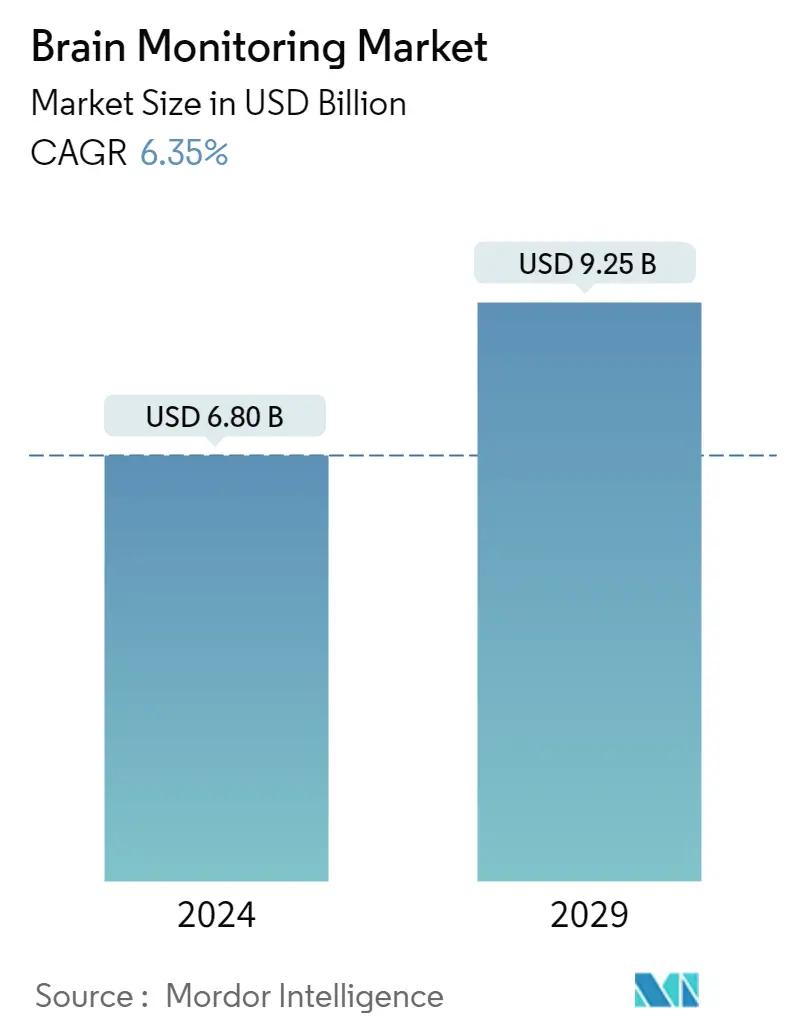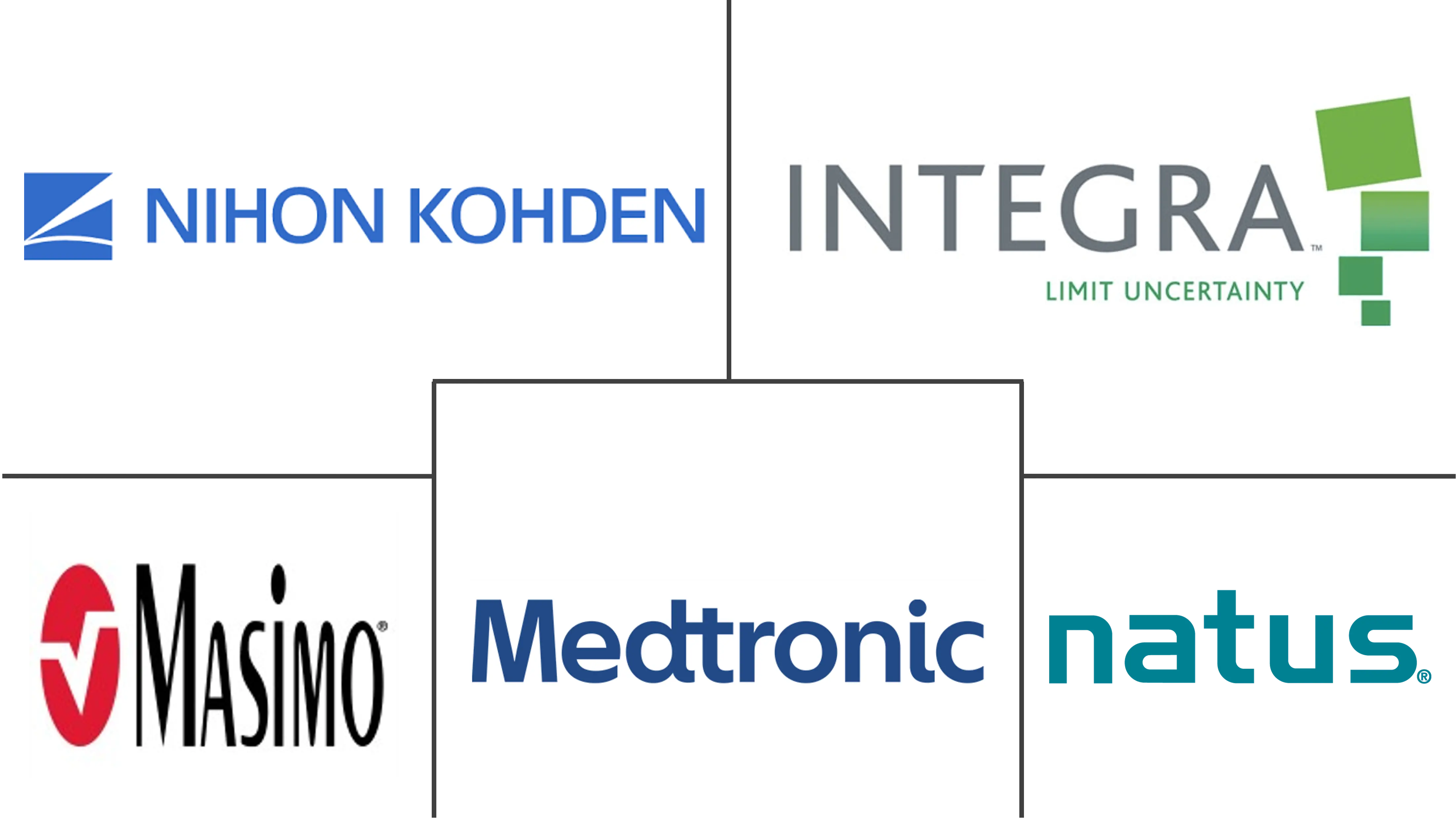Market Size of Brain Monitoring Industry

| Study Period | 2019 - 2029 |
| Market Size (2024) | USD 6.80 Billion |
| Market Size (2029) | USD 9.25 Billion |
| CAGR (2024 - 2029) | 6.35 % |
| Fastest Growing Market | Asia Pacific |
| Largest Market | North America |
Major Players
*Disclaimer: Major Players sorted in no particular order |
Brain Monitoring Market Analysis
The Brain Monitoring Market size is estimated at USD 6.80 billion in 2024, and is expected to reach USD 9.25 billion by 2029, growing at a CAGR of 6.35% during the forecast period (2024-2029).
- The COVID-19 pandemic significantly impacted the healthcare system, including the brain-monitoring devices market. Neurological screenings were delayed or canceled due to the global lockdown, leading to reduced access to care for people with epilepsy and negative consequences for people with Parkinson's disease. However, as brain monitoring services resumed and COVID-19 cases decreased, the market is expected to recover from the pandemic's decline.
- Several factors are driving the growth of the market, including aging demographics, the rising incidence of brain disorders, and the ease of device use and portability. For example, the population of Americans aged 65 and older is projected to grow from 58 million in 2021 to 88 million by 2050, with around 73% affected population aged 75 or older. Neurological diseases such as autism are prevalent worldwide, with World Health Organization (WHO) predicting that one in 100 children worldwide has autism. Thus, the increasing prevalence of brain disorders is expected to impact the growth of the brain monitoring market favorably.
- Strategic activities such as product launches, mergers, and acquisitions are also expected to bolster market growth. For example, NeuroWave Systems Inc. received Food and Drug Administration (FDA) clearance for its NeuroSENSE NS-901 Monitor, a brain function monitor for assessing anesthesia and sedation adequacy in clinical settings. Brain Scientific received FDA clearance for Next-Gen NeuroCap EEG Headset, an advanced electroencephalography (EEG) electrode array used to obtain rapid EEGs in routine clinical and research settings.
- Despite these factors, stringent regulations for device approval and a lack of skilled professionals are expected to restrain market growth. Overall, the brain monitoring devices market is expected to witness significant growth over the forecast period, driven by the increasing prevalence of brain disorders and product launches..
Brain Monitoring Industry Segmentation
As per the scope of the report, intracranial monitoring is a test for people with epilepsy whose seizures cannot be controlled with medication. Intracranial monitoring helps doctors pinpoint where seizures are starting in the brain. In addition, the tests help 'map' the brain, identifying areas that govern the brain's essential functions.
The brain monitoring market is segmented by product type (magnetoencephalograph, electroencephalograph, cerebral oximeters, functional magnetic resonance imaging (FMRI), intracranial pressure monitoring devices, and other product types), application (Parkinson's disease, traumatic brain injury, epilepsy, dementia, sleep disorders, and other applications), end user (hospitals, and diagnostic centers), and geography (North America, Europe, Asia-Pacific, Middle East, and Africa, and South America). The market report also covers the estimated market sizes and trends for 17 countries across major global regions.'
The report offers the value (USD million) for the above segments.
| By Product Type | |
| Magnetoencephalograph | |
| Electroencephalograph | |
| Cerebral Oximeters | |
| Functional Magnetic Resonance Imaging (fMRI) | |
| Intracranial Pressure Monitoring Devices | |
| Other Product Types |
| By Application | |
| Parkinson's Disease | |
| Traumatic Brain Injury | |
| Epilepsy | |
| Dementia | |
| Sleep Disorders | |
| Other Applications |
| By End User | |
| Hospitals | |
| Diagnostic Centers |
| Geography | ||||||||
| ||||||||
| ||||||||
| ||||||||
| ||||||||
|
Brain Monitoring Market Size Summary
The brain monitoring market is poised for significant growth over the forecast period, driven by factors such as an aging population, the rising incidence of brain disorders, and advancements in device technology. The market is recovering from the setbacks caused by the COVID-19 pandemic, which had led to delays in neurological screenings and reduced access to care. The increasing prevalence of conditions like autism and the growing demand for portable and user-friendly devices are expected to further propel market expansion. Strategic activities, including product launches and regulatory approvals, are also contributing to the market's positive outlook. However, challenges such as stringent device approval regulations and a shortage of skilled professionals may hinder growth.
The electroencephalography (EEG) segment is experiencing heightened adoption, particularly in intensive care units, due to its critical role in real-time monitoring and seizure detection. Innovations such as wireless EEG devices and rapid response monitoring technologies are enhancing the accuracy and efficiency of brain activity assessments. North America is anticipated to capture a substantial market share, supported by a robust healthcare infrastructure, increased healthcare spending, and a high incidence of brain disorders. The region's market growth is further bolstered by favorable reimbursement policies and technological advancements. The competitive landscape is characterized by the presence of major players and the emergence of mid-size to smaller companies introducing innovative solutions, ensuring a dynamic and evolving market environment.
Brain Monitoring Market Size - Table of Contents
-
1. MARKET DYNAMICS
-
1.1 Market Overview
-
1.2 Market Drivers
-
1.2.1 Growing Geriatric Population
-
1.2.2 Rise in Incidences of Brain Disorders
-
1.2.3 Technological Advancements in Brain Monitoring Devices
-
-
1.3 Market Restraints
-
1.3.1 Stringent Regulations for the Device Approval
-
1.3.2 Lack of Skilled Personnel to Handle Devices
-
-
1.4 Porter's Five Forces Analysis
-
1.4.1 Threat of New Entrants
-
1.4.2 Bargaining Power of Buyers/Consumers
-
1.4.3 Bargaining Power of Suppliers
-
1.4.4 Threat of Substitute Products and Services
-
1.4.5 Intensity of Competitive Rivalry
-
-
-
2. MARKET SEGMENTATION (Market Size by Value - USD million)
-
2.1 By Product Type
-
2.1.1 Magnetoencephalograph
-
2.1.2 Electroencephalograph
-
2.1.3 Cerebral Oximeters
-
2.1.4 Functional Magnetic Resonance Imaging (fMRI)
-
2.1.5 Intracranial Pressure Monitoring Devices
-
2.1.6 Other Product Types
-
-
2.2 By Application
-
2.2.1 Parkinson's Disease
-
2.2.2 Traumatic Brain Injury
-
2.2.3 Epilepsy
-
2.2.4 Dementia
-
2.2.5 Sleep Disorders
-
2.2.6 Other Applications
-
-
2.3 By End User
-
2.3.1 Hospitals
-
2.3.2 Diagnostic Centers
-
-
2.4 Geography
-
2.4.1 North America
-
2.4.1.1 United States
-
2.4.1.2 Canada
-
2.4.1.3 Mexico
-
-
2.4.2 Europe
-
2.4.2.1 Germany
-
2.4.2.2 United Kingdom
-
2.4.2.3 France
-
2.4.2.4 Italy
-
2.4.2.5 Spain
-
2.4.2.6 Rest of Europe
-
-
2.4.3 Asia-Pacific
-
2.4.3.1 China
-
2.4.3.2 Japan
-
2.4.3.3 India
-
2.4.3.4 Australia
-
2.4.3.5 South Korea
-
2.4.3.6 Rest of Asia-Pacific
-
-
2.4.4 Middle East and Africa
-
2.4.4.1 GCC
-
2.4.4.2 South Africa
-
2.4.4.3 Rest of Middle East and Africa
-
-
2.4.5 South America
-
2.4.5.1 Brazil
-
2.4.5.2 Argentina
-
2.4.5.3 Rest of South America
-
-
-
Brain Monitoring Market Size FAQs
How big is the Brain Monitoring Market?
The Brain Monitoring Market size is expected to reach USD 6.80 billion in 2024 and grow at a CAGR of 6.35% to reach USD 9.25 billion by 2029.
What is the current Brain Monitoring Market size?
In 2024, the Brain Monitoring Market size is expected to reach USD 6.80 billion.

